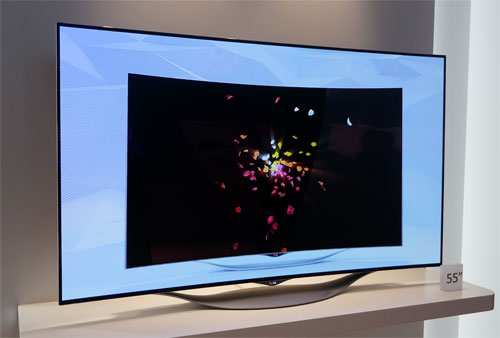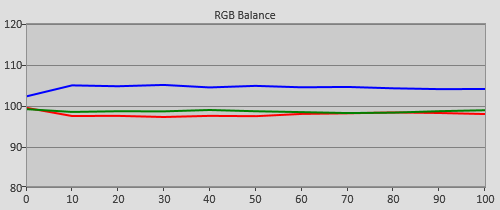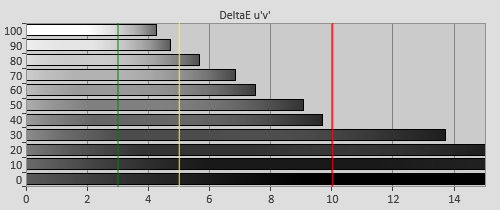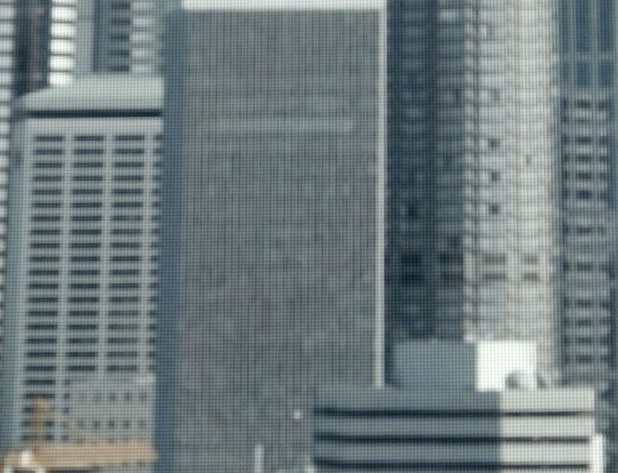With plasma technology’s coffin almost entirely nailed shut, who will restore deep, inky blacks to our home theaters? All signs currently point to LG Electronics, with the Seoul-based conglomerate currently the only industry player giving the fledgling OLED display technology anything other than lip service.

Its 55EC9300 is a 55-inch Organic Light Emitting Diode television which features 4 HDMI inputs, plenty of pixels with its Full HD 1920×1080 resolution, and the company’s swanky-looking WebOS interface. To the chagrin of videophile users, the display also features the trendy new curved screen, although the distortion is minimal.
Famously, LG is using a different approach on its OLEDs when compared to Samsung’s sole offering. Whereas Samsung are using actual red, green and blue subpixels much like an LCD (albeit with the subpixels arranged horizontally rather than vertically, for whatever that’s worth), LG’s pixels are split into four subpixels rather than three, the additional one being dedicated purely white. We’re told this is used to increase overall brightness and preserve the life of the display. What’s more, LG’s design makes use of color filters to generate red, green and blue light at the subpixel level. Apparently, it’s this difference that has given LG a manufacturing edge and is allowing them to push OLED technology. Geoffrey Morrison has published a very useful article on this subject over at CNET which we encourage you to check out.
Sure, 55″ is a little smaller than we’d like, but the EC9300 is also aggressively priced at about $3500 US, a fact that alone makes it an important and game-changing product – regardless of how it actually performs. Thanks to our friends at Value Electronics, we were able to spend some quality time with several 55EC9300 units. Let’s put this model through the HDTVTest analysis, and find out if it satisfies our eyes as well as our wallets.
Note: This OLED TV is marketed in the UK and Europe as the LG 55EC930V.
LG’s WebOS interface has become a media darling, although after using it for hours on end on this particular display, we were soon tired of it. Although it certainly looks great and is a million miles away from the clunky TV GUIs of old, after spending many hours interacting with the menus, we can say with authority that they can be a chore to use if you’re adjusting picture settings. Fortunately, this should matter only a minimal amount to the average user, but if you’re a calibrator, try doing a full 20-point grayscale calibration on an LG 55EC9300 (using the bundled “Magic Remote”) and you’ll soon understand why we wished we could just interface our computers directly with the TV.
![[Picture] menu](https://www.hdtvtest.co.uk/news/wp-content/uploads/2018/04/hdtv_US_LG-55EC9300_picture.jpg) |
| [Picture] menu |
Within these menus, you’ll find two “ISF Expert” presets, which a calibrator can label as “ISF Day” or “ISF Night” after their handiwork is complete. These modes feature both 2-point and 20-point grayscale calibration controls, and 3-axis control (hue/saturation/luminance) control over the six color gamut points. There are numerous other controls here, including an [Edge Enhancer], [Gamma] curve selection, and a combined spatial+temporal [Noise Reduction] filter.
The calibration controls on the LG 55EC9300 do not work properly. Although it’s possible to hammer out flat grayscale and gamma charts by using them, sit back and view some actual content and you’ll immediately notice the controls have introduced a significant amount of contouring into actual images, and a large amount of hue distortion into the color of blue tones (depending on what you had to adjust).
During Value Electronics’ 2014 flat panel shootout, Dewayne Davis, Kevin Miller and I spoke with engineers from LG Electronics (LGE), who shared some “best practices” for calibrating the 55EC9300 OLED TV with us. These involved setting some of the basic controls to predefined values before the calibration then adjusting them as required afterwards. Following this procedure did allow us to achieve flatter grayscale tracking, although having to calibrate using a different light output level then adjusting afterwards inevitably means that the end result will not be precise (the grayscale tracking will shift once the final light output has been dialed in). Regardless, it goes without saying that none of this should be necessary, seeing as considerably cheaper TVs from other manufacturers calibrate comparatively effortlessly.
One other problem we ran into during calibration was that the targeted 20pt adjustments we made did not always target the correct part of the luminance range. For example, adjusting the controls for 70% gray would actually change the RGB mixing of 75%.
Another annoyance is that the on-screen menus on the 55EC9300 significantly alter the color and luminance of the picture. In other words, the adjustments you make with the menu on screen are irrelevant, so calibrating involves making a calculated guess as to what the correct values might be, closing the menu, measuring, then re-entering the menu to further refine. LG’s 55EC9300 is not the only display to have this issue, Panasonic’s plasma televisions and also most of Samsung’s LCDs are affected too, but not to the same extent, and exiting and leaving the menus on those didn’t take as long thanks to their design.
Unfortunately (or for our sanity, fortunately?) it inevitably transpired that two LG 55EC9300s we spent the most time with were actually best left with their grayscale left uncalibrated, with the grayscale controls at their default position, because even the basic 2-point control introduces large color errors later. Grayscale adjustment controls should not affect anything other than the color of gray shades (hence the name), but on the 55EC9300, they have a huge effect on the hue and saturation of the colors that are laid on top. Both of our samples required us to make a large decrease to the low-end Blue control, but this actually ended up turning navy-blue colors into a seaweed green/ teal. (For good measure, we changed strategies and instead of lowering low-end blue, we instead raised low-end red and green to counter-balance, but the ultimate result was the same). A good example of the distortion this caused was in Argo, which, like most modern Hollywood movies, makes use of the “teal and orange” complementary colors aesthetic. On a display accurate to Rec.709, the grim Tehran winter seen through the windows of the captives’ safe-house is appropriately depicted as a cold-looking blue, but after calibration, the LG 55EC9300 portrayed it as a seaweed-like teal. We’re not on first-name terms with Mr Ben Affleck, his cinematographer or colorist, but we can tell you regardless that this wasn’t the intention of any of them.
After discovering this in addition to the other calibration difficulties, we started to feel that the LG 55EC9300 was carrying out psychological warfare on us. And in fact, we feel that the Imaging Science Foundation (ISF) is doing damage to its brand by allowing it to be so prominently displayed on a product with these issues. It’s not enough that the controls are simply present and can be used to generate flat-looking charts, if they inadvertently work against the goals of calibration.
Thanks to David Katzmaier of CNET, we were able to check out yet another LG 55EC9300 sample, which wasn’t affected by this issue because it didn’t need it’s low-end blue grayscale control adjusted much. That third review sample was actually too red by default, so we could dial that out without avoiding this issue. Still, display characteristics change with time, and LG need to fix this issue for owners who want to calibrate without worrying.
We did have one theory as to a potential workaround for this: calibrate grayscale in the service menu. The user-accessible grayscale calibration controls are implemented in software, whereas a service menu might have direct 2-point control over the R/G/B mixing of the panel itself operating at a higher level, therefore sidestepping the software issue we identified. Although we reached out to LG with this information, the company unfortunately did not respond to our requests, so we were unable to test our theory.
Therefore, the pre- and post-calibrated Grayscale tracking for the LG 55EC9300 ended up being one in the same. It’s too blue, and unless you can offload the calibration duties to a more capable video processor such as a Lumagen Mini3D, it’s best left that way, because the in-TV calibration controls are flawed.
  |
| RGB tracking and delta errors (dEs) |
Regarding Gamma, the 55EC9300 does have a [Gamma] control in its picture menus, with three selectable curves, two of which are 2.2 and the industry mastering standard (as decided in spec document BT.1886) of 2.4. The 55EC9300 did not deliver 2.4 in any of our tests, with the “2.4” preset actually delivering something closer to 2.25. That’s a shame, because the OLED panel’s amazing blacks would pair up very nicely with the 2.4 setup’s rich perceived contrast when viewed in a dark room. Naturally, we did try to knock luminance levels into the 2.4 range by using the 20pt controls, but this introduced the aforementioned contouring issues.
![Gamma tracking in [ISF Expert1] mode](https://www.hdtvtest.co.uk/news/wp-content/uploads/2018/04/hdtv_US_LG-55EC9300_pre-gamma.png) |
| Gamma tracking (~2.25) |
Color accuracy was fairly good, provided we didn’t touch the grayscale calibration controls, as we previously discussed. However, the color of cyan still distorts at high saturation levels. Interestingly, if you enable the wide color gamut mode on the EC9300, that problem goes away, but then you’re obviously left with over-cooked colors since we have only standard Rec.709 content to watch. We mention this because it’s clear the distortion is being caused by LG’s gamut remapping (since the nonlinearity goes away in the ‘native’ wide gamut mode) – another video processing issue.
![Color saturation tracking in [ISF Expert1] mode](https://www.hdtvtest.co.uk/news/wp-content/uploads/2018/04/hdtv_US_LG-55EC9300_pre-strack.jpg) |
| Color saturation tracking |
| Dead pixels | One dead pixel in lower-left, visible on red |
| Screen uniformity | Some color tinting noted on white fields on far left and far right of panel, not visible in most (non-hockey!) content |
| Overscanning on HDMI | Defeatable |
| Calibrated black level (black screen) | 0, image persistence causes tiny rise at times |
| Calibrated black level (ANSI checkerboard) | 0.0001 fL (0.0005 cd/m2) |
| Black level retention | No problems noted except for very slight rise in blacks in middle of panel (image retention related) |
| Primary chromaticity | Very Good (unadjusted), Average (with calibration controls bug) |
| Film mode deinterlacing | Passed common 60hz film cadence tests |
| Viewing angle | Green tint noted off-axis, except in the brighter whites |
| Motion resolution | LCD-grade: 300 baseline, 550-600 with interpolation No dark frame insertion mode |
| Digital noise reduction | Damaging non-optional NR strips out some fine details, defeatable only in otherwise problematic 60hz “PC Mode” |
| Sharpness | Varies, latest firmware version appears to have cured targeted sharpening of fine details, although very close inspection reveals occasional misplaced pixels (not in PC mode) |
| Luma/Chroma bandwidth | Full luma on chart, but resolution compromised by adaptive NR process (see above) Chroma is boosted, which can lead to jaggedness on colored edges |
| 24p Motion capability | Judder-free playback possible |
| Input lag (Leo Bodnar tester) | 45.9ms ([Game] mode) |
| Full 4:4:4 reproduction (PC) | Yes |
| 50hz signal support (HDMI) | Yes, perfect 50hz support |
If there was ever any category in which an OLED display would amaze us, this is it. The LG EC9300 produces zero black during a full black screen, and during mixed content, a shade of black that’s so dark that it will be immeasurable on most equipment. Our Klein K-10A (freshly black-level calibrated) rated it as being 0.
Unlike on an LCD TV, there is no visible black level penalty in turning up the [OLED LIGHT] control. Black level stays put at 0 cd/m2 on a dark screen, with the impressive ANSI black measurement rising from 0.0001 fL to only 0.0005 fL when we cranked the [OLED LIGHT] control up to its highest value (measured using a window pattern, our LG 55EC9300 could go as bright as 79 fL / 271 cd/m2, all while hanging onto these incredibly deep blacks).
The richness this lends to images cannot be understated. In a darkened room, low-APL scenes (think starfields in space) on the LG 55EC9300 make even the best plasmas, such as the Panasonic VT and ZT60, look grayish. And, unlike a plasma display panel (PDP), the 55in EC9300 has absolutely no problem producing eye-searingly bright whites. And unlike an LCD TV, it can produce those eye-searingly bright whites without turning the blacks into a milky gray (or more commonly, milky purple) shade. And, unlike a full array local dimming LCD TV, there are no haloing or flickering artefacts to spoil the show. Getting the message? For contrast performance, nothing beats OLED technology. Once again, hats off to LG for making the technology this affordable.
OLED displays have poor motion resolution by default, and like LCDs, need additional tricks to address the situation.
Unlike LCDs, the LG EC9300 doesn’t appear to have any pixel response time issues, where the pixels cannot physically open or close fast enough to avoid smearing (although we’d like to test this further in the future). That’s only part of the battle against motion blur, however. Like LCDs, and unlike plasmas and CRTs, OLED displays are using sample and hold driving, meaning that one frame is shown on the panel until it is replaced by the next one, without any black gap inbetween. The result is that the motion we perceive with our eyes and brain appears blurred during fast video content. The motion resolution, just like an LCD, is only 300 lines by default.
As with LCDs, it’s possible on the 55EC9300 to eek out more motion clarity, but only through the use of the [TruMotion] feature, which opens the door to digital interpolation glitches. Samsung’s OLED managed to resolve a full 1080 lines owed to its sample-and-hold busting Dark Frame Insertion mode, but LG’s 55EC9300 does not have this facility, and company engineers suggested that it was not possible to implement it (no word on how Samsung managed it). As usual, though, for the low frame rate of 24fps film, blur won’t be an issue despite the low native motion resolution.
During the Value Electronics technical event, we could quite clearly see that the LG OLED offered superior off-axis viewing angle performance when compared to Samsung’s, which looked considerably more reddish when not viewed face-on. By contrast, the LG 55EC9300 turned a little green off-axis, but the effect was far less than on the Samsung. OLED’s off-axis quality is not perfect, and while it’s still behind Plasma, it’s galaxies ahead of LCD, which performs very poorly in this area. While we’d like to see it improved, we don’t feel that it will be a major point of contention for many buyers.
Most of the samples we tested had white field uniformity issues on the far left and far right edges of the panels, taking on a slight green tint where the curve is at its most extreme. We also saw another sample which looked a little more reddish at the top, rather than the sides, so the curve may not be to blame.
By contrast, the Samsung OLED had no color smears across its picture, but like a plasma, dark gray fields would appear to have slight brightness discrepancies across them. Samsung’s display has the edge in screen uniformity, but LG’s has the lead in terms of off-axis viewing. Neither performed poorly in either area, both being fairly good but leaving room for improvement. (Since we mentioned plasma, let’s not forget the issues those displays sometimes had with color impurities appearing on bright white content).
The 55EC9300′s revolutionary contrast performance gives everything you watch on it an incredibly powerful, dynamic appearance. It is the most versatile display we’ve ever seen in this regard. No matter what you’re watching – dark content, bright content, and no matter your viewing environment – dark room, bright room – the image appears glossy and dynamic at all times. The contrast of dark scenes looks outstanding in a dark room, unlike on any LCD TV. Dark scenes look outstanding in a bright room too, unlike on plasma: the LG 55EC9300 does an outstanding job of rejecting ambient light, leaving a wet-looking, glossy black surface, even under light. Naturally, strong lights will leave reflections on the screen surface, so it’s still not the best idea to put the display right beside a window, for example… but the ambient light will not wash out the picture.
Beyond this, the LG 55EC9300 has some picture quality issues. We’ve touched on color accuracy already during the calibration section. After noting this, the main issue I noticed personally was a loss of detail owed to its noise reduction system, which cannot be fully disabled without other compromises. This immediately dampened my initial enthusiasm brought on by the outstanding contrast performance and comparatively low price tag. While the 55EC9300 has a menu control labeled [Noise Reduction], this is actually a second, stronger filter, which is optional (although we caught it enabling itself on several occasions during the review process despite being listed in the menu as “Off”). This point has confused a lot of users into thinking that full control is given over all NR filtering. It isn’t, there are actually two filters, and there’s only a menu option for one of them (which sometimes turns itself on behind your back).
So, the 55EC9300 averages out similar looking pixels that are in close proximity to one another, the intended effect apparently being to reduce camera sensor noise (or film grain). The end result is a softer appearance and a slight “watercolor painting” look. (If you’re interested in video processing, it appears to be an implementation of median filtering, although its application is not uniform across the entire image, and still keeps high contrast edges intact). Because the filter is not linear in its application – it appears to be programmed to keep the sharpness of edges – grain texture will be removed in some areas of the picture but not in others, which leads to spurious remnants which slip through the net and look like misplaced splats of noise.
As is the case with nearly all LG displays, this behavior can be defeated if you label the HDMI input as “PC” and send 60hz video to the TV, which enables a more processing-light display mode designed for use with computers. That means that you’ll have to kiss goodbye to native 24p playback and put up with 60hz pulldown judder, and you’ll also have to tolerate the fact that the PC mode has less accurate color. Still, being able to toggle between these two sets of compromises allows us to present a comparison of the LG EC9300 showing the opening montage from the Spears & Munsil Blu-ray Disc, taken off-screen with a locked-off professional camera:
Please note that the images below are close-up photos which show a detailed view of the screen. When viewed from several feet away, the differences will be less discernible depending on the viewer’s eyesight and familiarity with the content.
Click on the options below to compare modes:
[60hz PC Mode] | [Non-optional noise reduction]

In this example, the LG EC9300 blurs out a significant amount of the details in the darker areas of the trees. Interestingly, the brighter green parts of the bush in the center of the image fare better. The vertical railings on the cabin are also eaten into, and the definition between the angle on the roof, plus the line separating the window shutters, are almost completely obliterated.
Click on the options below to compare modes:
[60hz PC Mode] | [Non-optional noise reduction]

And in the second example, the LG EC9300 renders the defined skyscraper windows as one gray smudge, except for a point on the right which seems to have escaped the filter. The question remains, how visible will this be from your own viewing distance? That depends on the individual. Sit far enough back from any display and you won’t be able to resolve the finest details, including the ones that may or may not have been subject to in-TV tampering. Don’t forget that there’s also a psychological element to this, much like stuck or dead pixels on a television. Even if you can’t see issues from a few feet away, you know that they are present.
We feel that the fact that this processing can actually appear in a high definition (what part of that title has been lost on the engineers?) display – an HDTV bearing the logo of none other than the Imaging Science Foundation, no less – is indicative of this type of tampering not being taken seriously by AV professionals working in the consumer field. At present, it seems to be enough for most people if a consumer display can have its grayscale and color calibrated and flat-looking charts be presented as proof. Toy around with any other part of the video signal’s integrity, though, and you’ll be met with shrugs and excuses as to how it isn’t a big deal. In other words, we feel that calibration professionals and engineers are rightly concentrating on color science but are forgetting the other obligations they have in delivering “the whole picture, the right picture, and nothing but the picture”. Signal integrity is about more than flat bar charts.
On a happier note, we also saw some undefeatable high frequency edge enhancement in earlier firmware versions, however haven’t seen it since. We’re not sure if it was a bug or misfeature, but either way, hopefully it’s been banished for good.
As a result of all of this, the LG 55EC9300 presents an interesting experiment which requires to ask, just HOW important is contrast performance? And how many flaws in other areas can we tolerate before the allure of zero black is lost? No display we’ve seen before can touch it in this crucial area, but it’s bested in terms of color and luminance accuracy, plus in resolution, by televisions that cost 1/5th as much.
LG’s 55EC9300 offers a tantalizing glimpse into the promise of this outstanding display technology. The simple fact that it’s an OLED display is its biggest selling point: this panel technology bestows it with the best contrast performance we’ve ever seen on an HDTV. It can produce a sometimes incalculable contrast ratio owed to its absolute zero blacks, and can produce eye-searingly bright whites to sit alongside them. No other HDTV on the market, except for Samsung’s discontinued OLED (which cost more than twice LG’s offering) can make this claim. There’s no doubt about it, LG’s aggressive pricing is an absolute game-changer and we hope to see more affordable OLED coming from them soon.
Ultimately, how happy you are with the LG EC9300 depends on for how long you can remain wowed by the contrast performance, because thorough scrutiny reveals a number of issues lurking under the surface. In the hands of a company with a track record of attending to the desires of video enthusiasts – such as Panasonic, and in recent years, Samsung – it would be almost unfathomable that we could be anything less than raving about getting our hands on an OLED display. However, the unfortunate reality is that LG have compromised the video processing which feeds the amazing panel in several ways. Even if the calibration controls didn’t seriously skew some of the colors (therefore defeating their purpose), there is no way we could find to get the LG 55EC9300 to conform to the industry mastering gamma of 2.4 in spite of what the menu says. Even then, this wouldn’t defeat the EC9300′s “behind your back” noise reduction processing, which observant videophile users and film lovers will see as eating away at film grain textures and other fine details such as leaves, tree branches, etc. The fact that the company would deliberately include such a damaging feature does not fill us with confidence.
And confidence is what we need when it comes to LG right now, because as we said at the start of this review, they are the only company taking OLED seriously at this point in time – and for that alone, we congratulate them. Famously, the 55EC9300 came second place in Value Electronics’ 2014 flat panel shootout event in spite of the issues identified in this review. Other review outlets have also sung its praises. Other than the fact that this is probably the (English-speaking) world’s strictest review site, to this journalist personally, it suggests that people are craving affordable better-than-LCD (and better-than-plasma) contrast quality regardless of the other costs – at least in the short term.
The 55EC9300′s problem is that while it currently has the world’s best contrast performance, it is not the first display to do extremely well in this area. OLED contrast performance is on another level compared to the best plasmas, but Panasonic and Samsung’s final PDPs were still better all-round HDTVs, thanks to their very good (but obviously not OLED level) contrast with accurate grayscale, gamma, color, signal integrity, crisper (albeit at times dithered and noisy) motion, and low input lag for interactive usage. The LG EC9300 only excels above them in one of these areas – but wow, does it excel.
As a result, we give the LG 55EC9300 a Recommended rating through gritted teeth. Its multitude of problems left us considering the lower “Qualified Recommendation” but owed to its outstanding and unique contrast performance, its current uniqueness and its revolutionary price, it pulls itself into “Recommended” territory.
One last thing to end this review. About two years before the LG 55EC9300 began shipping, we reviewed a top-end European LCD TV from the company, the 47LM960V. It featured several of the same problems that eventually made it into the EC9300. And we ended that review by saying,
…LG can’t afford to keep shooting themselves in the foot with video processing hiccups. Once again, LG: please, please, please make sure that these quirks don’t cross over to your upcoming 55? OLED TV – that would be a fairly heartbreaking situation.
Hopefully for the next model, LG will have been reading and will fulfill their OLED promise by pairing these excellent panels up with a similarly excellent video processor. Until that time, the 55EC9300 will dazzle and irritate in unequal measures.

Note: We would like to extend our thanks to Robert Zohn, Wendy Zohn, and David Katzmaier for their assistance with this review.